The title of this write-up is a play on a painting called “Players of Strange, Meaningless Games” – a dark and eerie piece by New York-based artist Hawk Alfredson. Born in 1960 in Örebro, Sweden, Hawk arrived in America in 1995 and garnered an eager audience right away. In the mid-90s, New Art International praised him as “the darling of the New York underground art scene”.
A decade later, in 2006, Art & Antiques Magazine called him “one of the most collectible of the European Contemporary Surrealists of the new Century”. Thanks to Film Art LA, Hawk’s paintings have made it to the décor of movies like Ocean’s 13 (2007, Warner Bros.), Mystery Men (1999, Universal Pictures) and I Am Legend (2007, Warner Bros.).
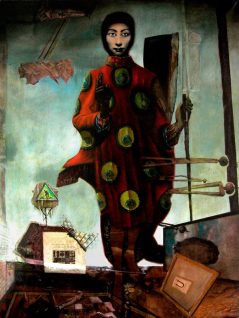

Hawk’s body of work is known for its distinctive Northern European tones and techniques. It is paradoxical in nature – dreamy and fantastical themes are executed in earthy shades of green, grey and brown. We get to encounter alien breeds of peripatetics, bright-eyed apparitions, organic circles, cosmic spirals. Shards of glass, crowns of thorns…
The paintings are weirdly suspended between ugliness and beauty – showing humanity both at its lowest and its highest. Uncouth males and females are exhibited in the middle of utter chaos. Then, serene men and women are projected as confident carriers of mystical wisdom. Taken as a whole, the art – at once real and unreal – disturbs, moves and entertains the viewer.
I caught up with Hawk recently to chat about his artist’s life.

Firstly, where does your odd, shadowy imagery emerge from? Is there a point of departure – an event or epiphany or encounter – behind your creativity that you are conscious of?
Yes, I would say there is one major incident, the consequences of which have affected me deeply as a person and an artist. Back in 1959, my parents lost a two-year-old. I was born exactly a year later in 1960. My parents were, of course, totally devastated and, in a way, the thought of doom was imprinted on me even before I was born. That lost child became a full and proper presence that permeated the mood of my life at all times, particularly until I moved to Stockholm at age 16 to attend art schools. Still, to this day, it affects me and everything I do, the sense of mystery in some of my paintings comes from this early trauma. My parents took me to doctors and hospitals frequently since they feared that I would die too.
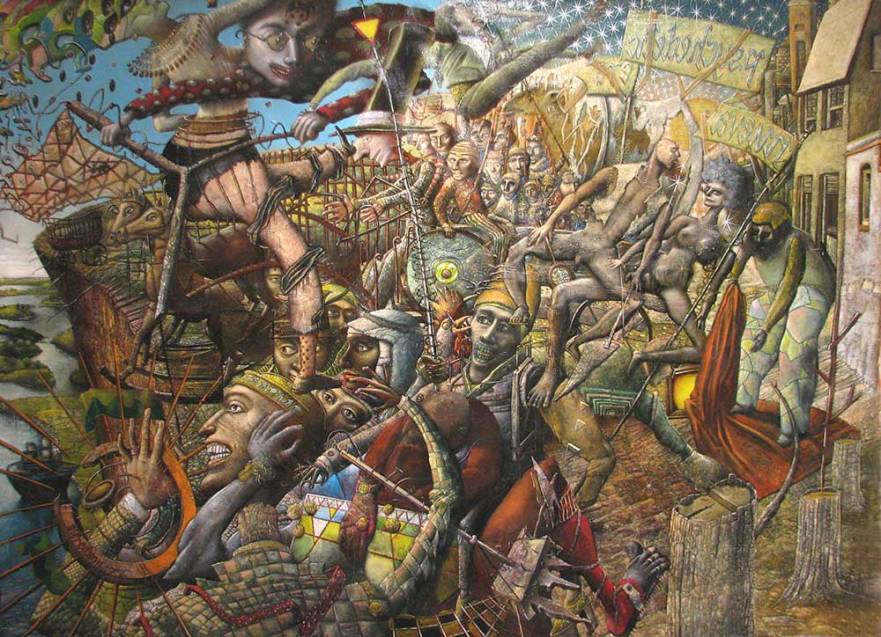


Tell me a little about your beginnings in Sweden. How did you become an artist? How did you develop this identity?
I have a feeling I was an artist in a previous life and have been reincarnated so that I can continue pursuing my passion in this one. I had support right from the beginning. My mother was born in Finland and my father in Sweden. A weekend painter, he taught me to paint in oil at age 7 after I had announced that I wanted to become an artist. Together we would study van Gogh’s works, especially the self-portraits. My mother had, before that, encouraged me to draw as she had noticed a talent in me for the same.

When I was 9, I started a correspondence course in drawing developed by the Swedish cartoonist Åke Skiöld. I worked on this almost daily for the next seven years. Furthermore, the absurd drawings of cartoonist Oskar Andersson, also known as ‘O.A.’, inspired me to create my own cartoons when I was very young. In my early teens, my drawings were published in the Swedish edition of Mad Magazine. I had my first group show at 16 and my first solo show at 19 – in 1980. The same year, I sold my first oil painting to the Swedish UFO magazine – UFO-Sverige Aktuellt – and it was shown at a museum in a UFO exhibition.

I had sporadic art shows mostly in Stockholm throughout the 1980s. One was at a bookstore café called Svarta Månen (“black moon”) which also had concerts, poetry readings and a local radio station. Israel “Izzy” Young had, for a short period, an office there too. Izzy is credited with having discovered Bob Dylan, and I have remained in contact with him since then. I always visit his Folklore Center in Stockholm when I’m in Sweden.
In 1988, I spent three months in West Berlin and four months in London in 1989. These were intense and chaotic experiences, especially in West Berlin where war tanks were rolling on the streets and the Wall was still standing. They led to some of my best works, like Stebuklingas Drugelis, Yaraia [featured image above] and Tight Antic II.



You mentioned you moved to Stockholm at age 16 to attend art school. How was your experience of formal art education?
I shifted to Stockholm and enrolled in Fetco’s School of Fine Arts. A year later, I attended Pernby’s Painting School. Once I started at Fetco’s, I was ready for bigger challenges. I would paint more regularly in oil now. Within the classroom, I got to scrutinize the detailed imagery of Dali and many other classic Surrealists. H.R. Giger and Beksinski were other strong visionary influences of mine during the late 70s. Some paintings by Karel Viteszlav Masek and Arnold Böcklin have had as much influence on my artwork as the Old Masters, with the motifs of Georges de La Tour and Jan van Eyck coming to mind in particular.
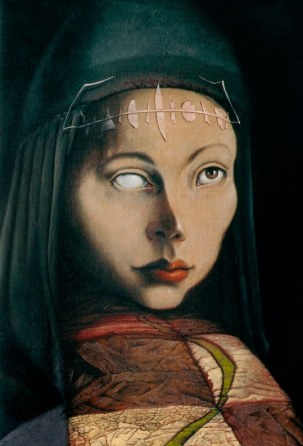
Stockholm, Berlin, London…finally New York. How did your move across the Atlantic affect your career and your life in general?
I moved to New York in 1995 and got a chance to quickly exhibit in nineteen group shows and two solo shows within the first year. There wasn’t a day in the mid-90s when my work wasn’t up on some wall somewhere in the city. The art scene was very concentrated. It was an incredibly delirious and exciting time.
In 1997, I met my wife Mia at a gallery in Park Slope, Brooklyn. She happened to live just a couple of minutes away. I was having a solo show there and she walked in one day when I wasn’t around and took a good look at all the paintings hanging from floor to ceiling. She was immediately hooked and tracked me down. Two years later, we were living together in Stockholm. A Swedish journalist wrote about our meeting: It was love before first sight. Mia felt Hawk’s presence, his language, yes, his entire being just by studying the details of his paintings.


I read that you lived in the historic Hotel Chelsea in Manhattan between 2001 and 2010. The landmark is legendary for the creative and eccentric nature of its tenants. The list of writers, musicians, actors, filmmakers and painters who have stayed there is long and astonishing. What was it like to be in such an important environment?
We lived in room #421 from 2001 to 2010. Dee Dee Ramone of The Ramones devoted an entire chapter to room #421 in his book “Chelsea Horror Hotel”. For him it was clearly a bad time in his life, but it was a very creative atmosphere for me. I had lots of daylight in the room and painted frequently. I had new and old work exhibited throughout the lobby, VIP-rooms, corridors and also along the ten flights of staircase space. I had 50-60 original oil paintings exhibited daily. The hotel was a quirky museum that was open 24/7.
Thousands of international visitors had the opportunity to discover and enjoy my work. Abel Ferrara’s documentary on the hotel – ‘Chelsea on the Rocks’ (2008) – included me speaking candidly about my experiences.

You have spoken about your interest in Magic Realism both in literature and in film, mainly the work of Russian filmmaker Andrei Tarkovsky and Austrian author Gustav Meyrink. What qualities of their work are you attracted to?
Mainly, it’s the otherworldly mood they create that I want to capture since I have often felt that life is like some sort of a weird dream. I believe their mystical vision is much closer to how life actually is than what we normally are taught to think.
What other authors and filmmakers do you feel have contributed to your personal vision?
Some of Ingmar Bergman and Alain Resnais’ films. And there are countless great writers who have taken me outside of what one usually might call ‘reality’ and into a world of their own creation. I love the magical, hallucinatory stories of Carlos Castaneda, Zoran Zivkovic, Hector Gramme, and Jeff VanderMeer, particularly his City of Saints and Madmen. I can completely identify with the alienated outsider feelings of the main characters in both Herman Hesse’s Steppenwolf and Eugene Ionesco’s The Hermit.

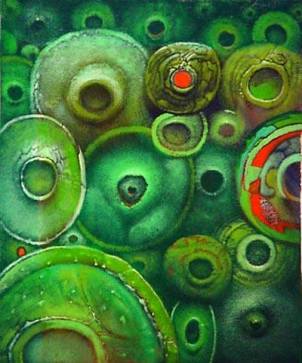
“Stranger At Dusk”, the recent short film about your paintings, has a unique voice. How did the film come about, specifically your collaboration with Gerald Busby (award-winning composer who has worked with Craig Lucas and Robert Altman)?
Gerald was a neighbor of mine at the Hotel Chelsea. Nearly every morning for nine years I could hear him at his piano. He lived on the fifth floor while Mia and I lived directly below on the fourth floor. He’s still there despite all the changes happening at the hotel. It was just natural that we would collaborate in some way.
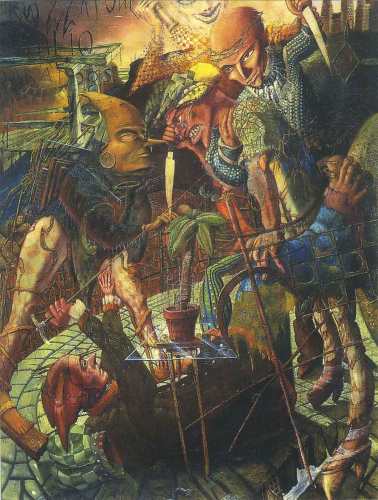
Your work seems to crossover genres and combine styles. Is this eclecticism a deliberate approach?
I work completely intuitively. Nothing is planned or sketched out. Even partway through a painting I couldn’t say for certain how it will end up. I welcome intervention from the spirits at all times so this is a large part of the eclectic result. Painting can be a chaotic experience. Many times it starts out this way, but once I get into the flow it becomes a Zen-like experience. This is how I know something interesting is happening on the canvas. Whether I am creating the art or viewing it, there’s always an element of enigma that should be present. I have never been so deeply affected by a single work of art as I have been by a painting of Alberto Giacometti. Spending time at a Paris museum in my early 20s, I came upon the painting and it truly mesmerized me and put me in a dreamlike, hypnotic state of mind where time and space disappeared. My experience there confirmed what I am after in my own work: to evoke a sense of timelessness, deep mystery and beauty. I wish to express a vision that not even I, the creator, fully understand.
—-
Hawk Alfredson’s works have been exhibited across New York and in the cities of Los Angeles, San Francisco, Chicago, Boca Raton, Boston and Baltimore. Spaces include nightclubs, avant-garde fashion shows and prestigious arenas like The Katonah Museum, the Prefectural Museum in Tokyo, New York’s Alternative Museum, Australia’s Regional Art Museum in Orange, NSW, and the historic Nordiska Museet in Stockholm, Sweden.
Learn more about Hawk Alfredson on his website (www.hawkalfredsom.com). You can connect with him on Facebook (www.facebook.com/artofhawkalfredson) and Twitter (@hawkalfredson). A book on his art – Players of Strange, Meaningless Games: The Art of Hawk Alfredson authored by Hector Gramme – is available on Amazon.
—-
Watch two videos below:
—-
![]()


Behtareen sakshatkar, beti rani.
LikeLike
I am unable to view the 2nd thought.
LikeLike
Stunning work! Thanks for publishing this.
LikeLiked by 1 person
Thanks for commenting! Very unusual work really…
LikeLiked by 1 person
Your work is AMAZING
LikeLiked by 1 person
Thanks for stopping by, Vicki. Glad you like the content. I have closed comments on my newer posts to encourage readers to like my Facebook page 🙂
LikeLike
If you wish to support this artist who really needs your help please contribute to his GoFundMe campaign here:https://www.gofundme.com/HelpHawkPaint
This is an incredible artist who is presently hobbled with a lack of resources. If the artistic community helps him out he will be able to reach new heights in production of these wondrous pieces of art.
He needs our help. Please support him.
LikeLiked by 1 person
Thanks for posting this here, Julie.
LikeLike